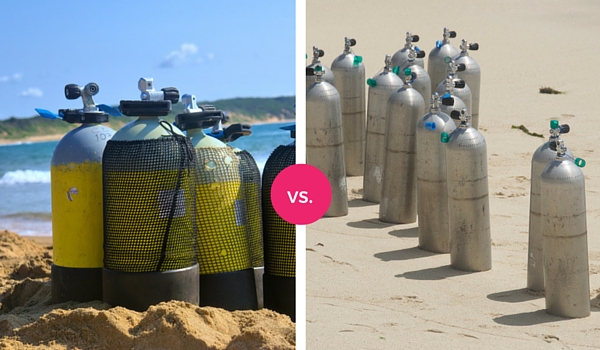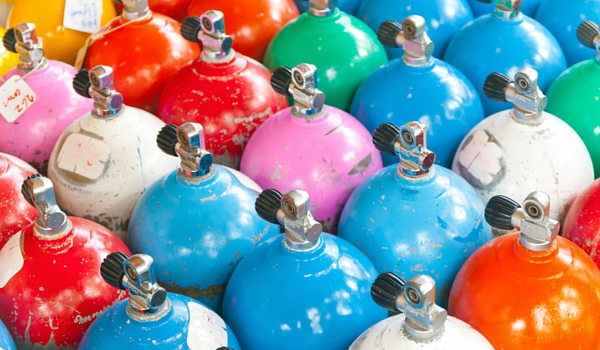How Steel vs Aluminum Scuba Tanks Will Effect Your Buoyancy?
Do you know how a steel or aluminum scuba tank affects your buoyancy?
I am pretty sure you used an aluminum 80 on your last dive and seldom gave it a second thought why you did. It is most likely this is the size tank you used for your first open water dive, and you are using it ever since.
In the one size fits all mindset, these tanks are the standard that dive centers, liveaboards, and dive boats use. The other reason they are popular is that they are inexpensive. Aluminum tanks cost about half of the same size steel.

Steel tanks vs. Aluminum tanks which one should you choose?
When you are fine tuning your diving skills or are considering buying your own dive cylinders then, you need to expand your thinking and include the possibility of a steel cylinder. Let’s look at an 80 cubic foot aluminum and 80 cubic foot steel tank to get you started to think about what may be the best scuba tank for you.
Are You An Average Size Diver?
Is there still such a thing as an average size diver? The last two or three decades have seen an increase in female divers and young children taking up the sport.
Often their stature is smaller than an average male, but they are still using the same 26.1-inch (66 cm) high tank. A shorter steel tank would be easier to use for most smaller divers as a steel 80 is only 20.1 inches reducing the height by a full 6 inches. (15 cm)
Steel and Aluminum Tanks Have Different Effects on Your Buoyancy
Let’s start with the weight of the tanks on the surface. When you pick up a tank, you will notice the aluminum tanks are slightly heavier than the steel ones although we know aluminum is lighter than steel.
The tank is heavier because aluminum is softer than steel and, therefore, more material is needed to manufacture the tank so it can withstand the same pressure at depth as the steel version.

The paint on a scuba tank acts a protective layer
What is are the differences between Steel and Aluminum tanks?
The numbers we will use in the example below are for the aluminum Luxfer 80 and the steel Faber 80 scuba tank used in salt water. These are two of the most popular scuba tanks, and their values are representative of tanks built from the same material.
The weight difference between full and empty for both of these tanks is 5.9 pounds (2,6 k.g) Since we never should use all the air in the tank, it is more practical to say we use about 4.5 pounds (20 k.g) of air on a dive.
After a day of diving anywhere around the world, you often see, the crew lowering the empty cylinders into the water and floating them to the shore. If you would do that with an “empty” steel tank, it will sink. That is because the aluminum tanks are positively buoyant after a dive while the steel tanks are negative.
A Luxfer 80 tank filled with 3000 PSI (200 bar) breathing gas is 1.5 pounds negatively buoyant and at 750 PSI (50 bar) that same tank is 3 pounds positively buoyant.
The steel Faber 80 starts a dive being 13 pounds negative and at the end of the dive is 8.5 pounds negative also at 500 psi. In both cases, 4.5 pounds of gas was used. The question now is how does that affect the diver?
[the_ad_group id="1249"]
Let’s use a diver that weights 160 pounds wearing a 3 mm wetsuit as our example
If we use the PADI Peak Performance Buoyancy guideline, this diver needs 8 pounds of weight to be neutrally buoyant.
The goal is for the diver to finish the dive with 750 psi (50bar) remaining and being neutral buoyant without air in the BCD at 15 feet/ 5 meters.
When he puts on an aluminum tank, he becomes about 1.5 pounds negatively buoyant. Without air in his BCD, he will slowly sink. At some point, he will add air to his BCD to regain neutral buoyancy and stop his descent.
As he uses his air, the tank changes from a negative to a positive buoyant state, when he has used about one-third of his air, the Luxer 80 is neutrally buoyant, and the diver will need to remove all air from the BCD to remain neutral.
As he uses more air, he will become positively buoyant and start to float up. As we mentioned before, he will use about 4.5 pounds of air-breathing down to 750 psi.
Also read: Here is How You Should use Your Weights for Perfect Buoyancy
So starting with a 1.5 negative and removing 4.5 pounds of air means the diver needs to add 3 pounds of weight to get back to his neutral buoyancy weight. This diver will need 11 pounds on his belt when using an aluminum Luxfer 80 cylinder.
Now the same diver puts on a full steel tank weighing 13 pounds. Without air in his BCD, he would sink like a rock so he would need to add air to compensate.
After breathing his air down to the 750 PSI level, his tank is still 8.5 pounds negative. To be neutral at 750 psi, he will need to remove that 8.5 pounds from his weight belt.
Conclusion based on the example above: A diver switching from an aluminum tank to steel will need 11 pounds less on his belt.
A real-life example
A good friend was a real air hog when he first became an open water scuba diver, and he had a problem maintaining proper buoyancy control. His instructor suggested the peak performance buoyancy course and a few dives using a steel 100. This accomplished two things as a stop-gap measure.
First, the extra air gave everyone extra bottom time. The 20% increased in the air allowed him to match the dive time of the other divers in the group. Since the steels were still negative at the end of the dive, he could now remove some weights from his weight belt.
This allowed him more space on the weight belt to help adjust the trim and made his diving more efficient. After a few dives, his air consumption improved, and he downsized to a steel 80. When he mastered buoyancy with the steels, he started to dive again on the aluminum.
[the_ad_group id="1250"]
How Should You Properly Maintain your Scuba Tank?
Rust is often mentioned as a drawback to a steel tank. If salt water gets into a tank, it will rust, and it will not take long for the rust to weaken the tank. Aluminum tanks have a similar problem, but when this process happens in aluminum it forms a coating that prevents the process from continuing.
However, if you do not get salt water in the tank, then it won’t rust. If a steel tank starts to rust because of moisture in the air, a process called tumbling can be used to remove any rust that is starting to build.
Since aluminum tanks are softer than steel, they are more prone to external nicks from handling them. Both styles of tanks when properly cared for will last a long time, but steel tanks do have a longer life expectancy.
Also read: How You Should Take Care of Your Scuba Dive Equipment
Which tank is best for you?
The only way to know which one is best for you is to try them. While the aluminum 80s are the most common, many dive centers will have a few steel tanks on hand. Ask ahead of time is using a steel tank can be arranged and give it a try.
[the_ad_group id="1251"]This article is written by RUSHKULT and published by The Scuba Page, the online magazine for Scuba Dive lovers around the world. The Scuba Page is part of RUSHKULT: the online booking platform for adventure sports. Visit the RUSHKULT platform to book your next Scuba Dive training, guided trip, and accommodation.

Leave a Comment